Services on Demand
Journal
Article
Indicators
-
 Cited by SciELO
Cited by SciELO -
 Access statistics
Access statistics
Related links
-
 Cited by Google
Cited by Google -
 Similars in
SciELO
Similars in
SciELO -
 Similars in Google
Similars in Google
Share
Universitas Psychologica
Print version ISSN 1657-9267
Univ. Psychol. vol.12 no.spe5 Bogotá Dec. 2013
A near-infrared spectroscopy study of differential brain responses to one or two-handed handing actions: An implication for cultural difference in perceived politeness
Un estudio de espectroscopía casi a infraroja de respuestas cerebrales diferenciadas en acciones de una o dos manos: una implicación para la diferencia cultural en la cortesía percibida
Keiko Tagai*
Shiseido Research Center, Kanagawa, Japan
Sadaki Takata
Shiseido Research Center, Kanagawa, Japan
Masayoshi Nagai**
The National Institutes of Advanced Industrial Science and Technology (AIST), Japan
Katsumi Watanabe***
University of Tokyo, Japan
Takatsune Kumada****
The National Institutes of Advanced Industrial Science and Technology (AIST), Japan
*Shiseido Research Center, Kanagawa, Japan. E-mail: keiko.tagai@to.shiseido.co.jp
**The National Institutes of Advanced Industrial Science and Technology (AIST), Ibaraki, Japan. E-mail: masayoshi-nagai@aist.go.jp
***University of Tokyo, Japan. E-mail: kw@fennel.rcast.u-tokyo.ac.jp
****The National Institutes of Advanced Industrial Science and Technology (AIST), Japan. E-mail: t.kumada@aist.go.jp
Recibido: junio 1 de 2012 | Revisado: agosto 1 de 2012 | Aceptado: agosto 20 de 2012
Para citar este artículo
Tagai, K., Takata, S., Nagai, M., Watanabe, K., & Kumada, T. (2013). A near-infrared spectroscopy study of differential brain responses to one or two-handed handing actions: An implication for cultural difference in perceived politeness. Universitas Psychologica, 12(5), 15711585. doi: 10.11144/Javeriana.UPSY12-5.niss
Abstract
In interpersonal communication, body posture and nonverbal behavior serve as important channels for transmitting social signals and these often vary among cultures. Specific body postures and actions have not only functional, but also affective elements. For example, in Japan, handing an object to another with both hands is considered polite behavior whereas using only one hand is not. In this study, we have examined whether handing with both hands and handing with one hand would produce indications of differential brain activities in the receiver, and whether this activity would differ among people with different cultural backgrounds. Changes in oxy-Hb concentration were measured by 48-channel near infrared spectroscopy (NIRS) from 51 female participants (25 Japanese and 26 non-Japanese). The experimenter handed a bottle to participants using both or one hand. Results showed different amounts of change in oxy-Hb concentrations in the inferior frontal regions, depending on whether one hand or both hands were used. Moreover, the pattern of brain reactions in the inferior frontal regions differed between our Japanese and non-Japanese participants. A discriminant analysis of differences in oxy-Hb values suggested that the degree of oxy-Hb reaction in the right side of inferior frontal regions could predict to which group the participants belonged. These results suggest that different cultural and habitual backgrounds may lead to different NIRS activity while interpreting another's actions, and oxy-Hb IFG concentration may reflect differential interpretations of another's actions.
Keywords authors: NIRS, cultural differences, body posture, action, politeness.
Keywords plus: Culture, Habits, Cognitive Science.
Resumen
En la comunicación interpersonal, la postura corporal y el comportamiento no verbal sirven como canales importantes para la transmisión de señales sociales y estas por lo general suelen variar entre culturas. Las posturas corporales específicas y las acciones tienen no sólo elementos funcionales, sino también afectivos. Por ejemplo, en Japón, la entrega de un objeto a otro con las dos manos se considera conducta cortés, mientras que con una sola mano no lo es. En este estudio, hemos examinado si la entrega con las dos manos y la entrega con una mano producen señales de actividad cerebral diferencial en el receptor, y si esta actividad sería diferente entre las personas con diferentes orígenes culturales. Los cambios en la concentración de oxi-Hb fue medida por espectroscopia de infrarrojo cercano de 48 canales (NIRS) de 51 mujeres participantes (25 japonesas y 26 no japonesas). El experimentador le entregó una botella a los participantes utilizando una o ambas manos. Los resultados mostraron diferentes cantidades de cambio en las concentraciones de oxi-Hb en las regiones frontales inferiores, dependiendo de si se utilizaba una o ambas manos. Por otra parte, el patrón de las reacciones cerebrales en las regiones frontales inferiores difiere entre los participantes japoneses y no japoneses. Un análisis discriminante de las diferencias en los valores de oxi-Hb sugirió que el grado de reacción de oxi-Hb en el lado derecho de las regiones frontales inferiores podría predecir a que grupo pertenecían las participantes. Estos resultados sugieren que los distintos orígenes culturales y de hábitos puede dar lugar a actividades diferentes en NIRS, mientras que al interpretar las acciones de los otros, y la concentración de oxi-Hb en IFG puede reflejar interpretaciones diferenciales de las acciones del otro.
Palabras clave autores: NIRS, diferencias culturales, postura corporal, acción, cortesía.
Palabras clave descriptores: Cultura, hábitos, ciencia cognitiva.
doi: 10.11144/Javeriana.UPSY12-5.niss
Introduction
In interpersonal communication, body posture and physical actions serve as important channels for transmitting social signals and these often vary among cultures. Specific body postures and actions can, for example, express consideration and thoughtfulness to others. In many Asian cultures, handing an object with both hands not only has a functional purpose of passing the object to another, but also expresses consideration and thoughtfulness to others. In cultures such as the Chinese, Korean and Japanese, handing an object with both hands generally connotes consideration and respect to the receiver. In Japan, such action can be seen in the traditional tea ceremony as an ethnic practice.
Though it may appear standoffish for people who are not accustomed to it, handing with two hands has remained a common expression of respect and hospitality, and as a polite way to pass an object in daily life (Surak, 2006). Touyama (1991) mentioned, "Although the Japanese life style today is greatly westernized, Japanese nonverbal behavior is still regulated by traditional Japanese culture." (p.181). Furthermore, Ikegami (2005a) suggested that the code for politeness changed in the Edo period (1603-1868) from one based on a feudalistic hierarchy, to one based on a commercial environment. Wealthy merchants emphasized not only business disciplines and ethics but also the manners and behaviors for dealing with customers. According to Ikegami (2005a), this conversion affected the rise of a culture of "polite capitalism" in Japan.
Brown and Levinson (1987) have pointed out two other aspects of the interactive expression of politeness through good manners in their theory of politeness, power and distance. Ikegami (2005b, in Japanese) described those points in her words, "In the American office culture, lowering the level of politeness leads to closeness in mental distance, which then causes a pretentious equality of power, which results in no superiors or inferiors." (p.443). For instance, services at cosmetic counters in shops outside of Japan appear more casual, and the relationship between customers and salespersons is more equal. On the other hand, at Japanese cosmetic counters the value placed on politeness during store services may be related to the effects of Japanese culture, such as handing an object with both hands, a custom that originated in the traditional tea ceremony. Thus, handing actions represent not only functional elements but also affective elements to the receiver of the action.
Additionally, Wadsworth and Kana (2011) demonstrated that there were differences in brain reactions between men and women when they imaged actions related to functional elements, such as using an instrument. The authors argued that such differences reflect familiarity with using the instrument.
It could be expected that functional elements of actions would similarly result in different brain reactions, depending on the familiarity of a person with the actions. Although functional elements may show little difference between cultures, affective elements may reflect cultural and customary differences. Adams, et al. (2009) showed that, when photographs of various eye shapes were presented and participants were asked to discern a mental state from the eye shapes, there was an intra-cultural advantage in mental-state decoding. In addition, a greater recruitment of bilateral posterior superior temporal sulcus was found in functional magnetic resonance imaging (fMRI) signals during same- versus other-culture mental-state decoding. These results on surmising states of mind suggest there are cultural differences in the interpretation of emotional and affective elements of others' expressions.
Previous studies revealed neural activities of participants while interpreting the intention of actions performed by another person. The origin of this line of research was the discovery of mirror neurons in the premotor cortex of the macaque monkey by Rizzolatti, Fadiga, Gallese, and Fogassi. (1996). A mirror neuron is a neuron that fires both when a monkey performs an action itself, as well as when it observes the same action performed by another agent. The discovery of mirror neurons in monkeys has prompted research in humans (e.g., Rizzolatti, Fogassi, & Gallese, 2001), based on the assumption that there might be a comparable neural system in humans. A recent meta-analysis by Caspers, Zilles, Laird, and Eickhoff. (2010) examined 139 studies that used fMRI and positron emission tomography (PET) with activation likelihood estimation (ALE) of action observation and imitation in human brain activity. They concluded that observation of hand actions was consistently associated with activation in the inferior frontal gyrus (IFG, BA44), premotor cortex (PMC, BA6), and inferior parietal lobule (IPL). These may be considered to comprise a mirror neuron system in the human brain.
It is known that activities in the human mirror neuron system may be affected by how the receiver understands the intention of the action. Iacoboni, Molnar-Szakacs, Gallese, Buccino, Mazziotta, and Rizzolatti (2005) found differential brain activities while participants observed an action of reaching out and picking up a cup and drinking the contents compared to picking up the cup and then putting it away. This result suggests that the mirror neuron system is involved in understanding the intentions of an action in different contexts. This indicates that the mirror neuron system is influenced not only by the perception of an action, but also by the affective aspect of the action. Further, a study using near-infrared spectroscopy (NIRS) found increased concentrations of oxygenated hemoglobin (oxy-Hb) in regions in the inferior frontal gyrus (BA45), precentral gyrus (BA6, BA44), and superior temporal sulcus (BA22) when participants were handed an object in a way that was easy to receive, compared to when they were handed it in a way that was difficult to receive (Shibata, Suzuki, & Gyoba, 2007).
This study was part of a series of investigations examining the brain mechanism for interpreting "politeness1" in one-on-one, face-to-face settings, which has not been directly addressed in previous research. In this study, we first examined whether there are specific brain activities that would differentiate between handing objects with both hands (likely to be interpreted as "polite") from handing with one hand (likely to be interpreted as "impolite"), using NIRS. NIRS allows the measurement of neural activities, while performing handing actions in actual face-to-face situations at a stimulated cosmetic sales counter. Since women purchase cosmetics through face-to-face sales more frequently than men, we recruited female participants, with the expectation that they would show their ordinary psychological and physical behaviors during the face-to-face setting of the experiment. Further, we compared Japanese participants, who were accustomed to handing objects with both hands to convey politeness, to non-Japanese participants, in order to test whether there would exist any difference in brain responses that are possibly modulated by cultural the background.
Method
Participants
A total of 51 healthy, right-handed, female participants took part in the experiment for payment. Twenty-five participants were born in Japan with no experience of living abroad for extended periods (mean age 29.2 ± 5.9 years) and classified as the Japanese group. The remaining 26 female participants were born and raised outside Japan, in China (N = 6), USA (N = 8), Germany (N = 7), Mexico (N = 1), Argentina (N = 1), Italy (N = 1), Chile (N = 1), and Brazil (N = 1), with a mean age of 31.73 ± 4.29 years. These participants had lived in Japan for a mean length of 66.9 ± 57.2 months, and were classified as the non-Japanese group. Participants provided informed consent in accordance with the guidelines approved by the National institute of Advanced Industrial Science and Technology, Japan.
Procedure
We instructed each participant to imagine that she was a cosmetics customer and the shop assistant was now going to pass her a bottle of face lotion. After a rest period (60 seconds), the experimenter handed the bottle to the participant by using either (a) one hand from the front ("neutral" condition), (b) both hands from the front (both-hands or "polite" condition), or (c) one hand from above (one-hand or "impolite" condition; Figure 1). Each action was completed in 15 seconds. The participants received the bottle with their dominant right hand. Once they received the bottle, they put it down by their side. A single session consisted of four trials of the neutral condition, followed by either the both-hands or one-hand condition. Each participant completed two sessions (Figure 1). A previous study has reported that habituation of oxy-Hb and deoxy-Hb in the vascular response to a visual stimulation, as well as the visual evoked potential amplitude (Obrig, Israel, Kohl-Bareis, Uludag, Wenzel, Muller, & Villringer, 2002). Therefore, we applied the effect of habituation to the neutral condition and reduced it to either the both-hands or one-hand condition for comparison.
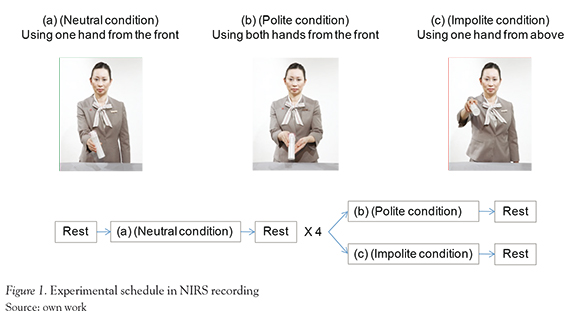
Near-infrared spectroscopy
A multichannel near-infrared spectroscopic (NIRS) system (ETG-4000, Hitachi Medical Corp.) was used to measure brain activity. The NIRS unit operated at near-infrared wavelengths of 695 and 830 nm, and measured changes in concentrations of oxy-Hb, deoxy-Hb, and total-Hb. We used a pair of probe holders, each consisting of 4 X 4 arrays; 16 optodes (8 emitting and 8 detecting) constituted 24 channels in each probe. The distance between each emitting and corresponding detecting optode was 3.0 cm. The sampling rate at each channel was approximately 10 Hz. The probes were placed on the frontal region of each hemisphere (see Figure 2). Cz in the international 10/20 system was set to align with the connecting line between the positions at the superior/posterior corners of the arrays (i.e., the emitter for the right probe and the detector for the left probe). Fz was aligned with the middle of the two connecting lines between the positions at the superior/anterior corners of the arrays and between the positions at the superior/second from the anterior intersections of the arrays.
The position of each column of emitters, or detectors in the arrays was parallel to the midline of the brain. By this probe placement, 48 channels covered the bilateral middle to inferior frontal, and superior temporal and anterior parietal regions. The positions of the 48 channels were estimated on the MNI space by virtual registration technique (Oka-moto et al., 2004 and Okamoto & Dan, 2005), as shown in Figure 2b.
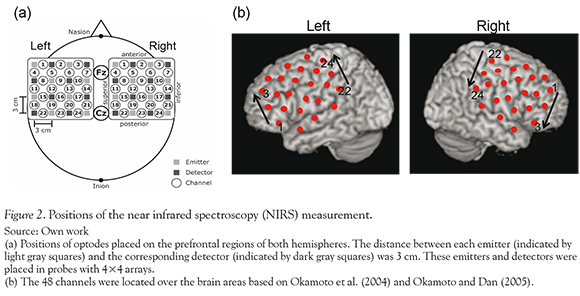
Subjective ratings of action
After the NIRS measurement, the participants provided 11 subjective ratings for their impressions of the different handing actions using a 100-point scale: (1) ease of receiving the bottle, (2) elegance of the action, (3) professionalism of the action, (4) likeability of the action, (5) sensitivity of the action, (6) gracefulness of the action, (7) neatness of the action, (8) pleasantness of the action, (9) attractiveness of the product, (10) participants' interest in the product, (11) participants' willingness to use the product.
Results
Subjective ratings
All the subjective ratings were significantly higher when both hands were used to hand the product than when only one hand was used, irrespective of the cultural group (Japanese and non-Japanese; Table 1). Specifically, participants described the handing action of using both hands from the front as a polite action and the handing action of using one hand from above as an impolite action.
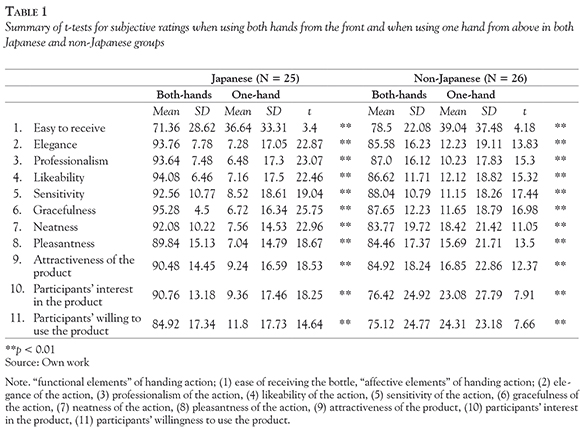
The 11 subjective ratings were classified into three subtypes: [a] "functional elements" of the handing action, which included how easy it was to receive the bottle, [b] "affective elements" of the handing action, which included elegance, professionalism, likeability, sensitivity, gracefulness, neatness, and pleasantness, and [c] "appreciation" of the handed object, which included the attractiveness of the product, interest in the product, and the willingness to use the product.
Correlations between subjective ratings within each subtype were high in both handing action conditions for all three groups, i.e., all participants, Japanese, and non-Japanese. Therefore the subjective ratings were averaged within each subtype. Correlations among the averaged ratings of the three subtypes were calculated for one-hand and both-hands conditions, separately for the Japanese and non-Japanese groups. In the one-hand condition, functional elements of handing, affective elements of handing, and appreciation of the product were all significantly correlated with each other. In contrast, in the both-hands condition, while affective elements were significantly correlated with appreciation of the product and with functional elements, there was no correlation between functional elements and appreciation of the product (Table 2).
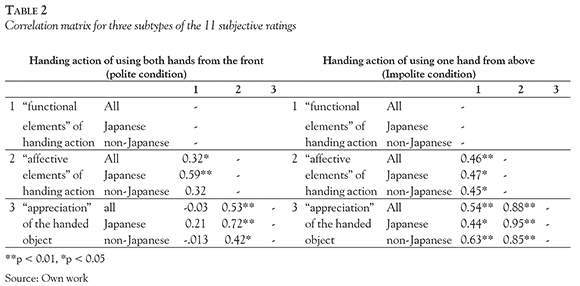
These findings suggest that the difference in handing action using one hand, or both hands produced different relationships between appreciation of the product and functional elements of the action. In particular, when both hands were used, appreciation of the product was evaluated independently of how easy it was to receive.
NIRS data analysis
We focused on the oxy-Hb concentrations as the index of neural activation because they are most sensitive to changes in regional cerebral blood flow and are correlated with the blood oxygenation level dependent (BOLD) signal (Hoshi, Kobayashi, & Tamura, 2001; Strangman, Culver, Thompson, & Boas, 2002). Trials with movement artifacts, as determined by steep changes in the time series of the concentration of both oxy-Hb and deoxy-Hb, were removed from the analysis. A drift correction was performed by calculating values of oxy-Hb concentration relative to the baseline (connecting line between 5 sec pre-time and the last 5 sec rest-time data of oxy-Hb). If the calculated relative values of oxy-Hb concentration included artifacts such as alternating current noise due to poor contact of probes to the skin, among others, data from those channels were deleted in all the conditions. A total of 456 recordings were excluded from the analysis.
The average waveform measure of each condition was calculated for each channel for the Japanese and non-Japanese participants. The waveform measured in the neutral condition was obtained from the four trials just before the both-hands condition and the one-hand condition. The peaks of oxy-Hb concentration were identified and the mean oxy-Hb concentration, as changes accumulated during the 10-sec period of 5 sec before and after the peak, was defined as the oxy-Hb concentration for the task. With the Japanese participants, oxy-Hb concentration in the inferior frontal regions (right 6ch) tended to be greater in the both-hands condition than in the one-hand condition and the neutral condition. With the non-Japanese participants, by contrast, oxy-Hb concentrations tended to be greater in the one-hand condition than in the both-hands condition and the neutral condition (see Figure 3).
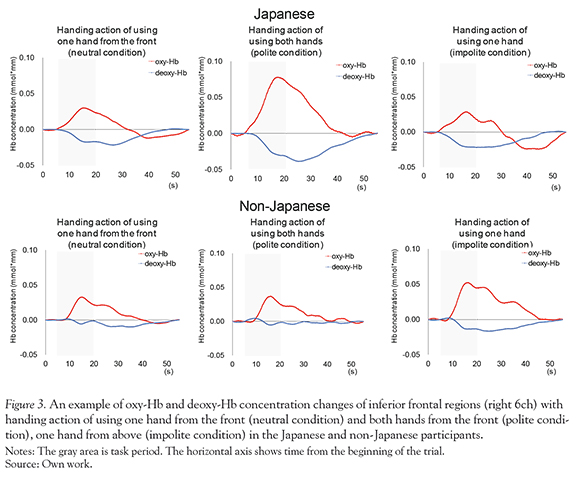
As shown in Figure 4, significantly greater oxy-Hb concentrations were observed when Japanese and non-Japanese participants observed the one-hand action, as compared to the both-hands action within the left superior temporal regions (left 18ch, t (34) = -2.47, p < 0.05). For the Japanese participants, the bilateral inferior frontal regions showed greater oxy-Hb concentrations for the both-hands condition than with the one-hand condition (left 5ch, t (24)= 2.58, p < 0.05, right 6ch, t (24) = 2.12, p < 0.05), and the left superior temporal regions showed greater oxy-Hb concentrations for the one-hand condition than the both-hands condition ((left 18ch, t (24) = -2.12, p < 0.05). For non-Japanese participants, the right inferior frontal regions and bilateral middle temporal regions showed significantly greater oxy-Hb concentrations for the one-hand condition than the both-hands condition left 4ch, t (25) = -3.14, p < 0.05,right 3ch, t (25) = -2.57, p < 0.05, BA 21 ; right 7ch, t (25) = -2.23, p < 0.05). These results indicate that observing the handing action of the object while receiving it differentially influenced neural activations in bilateral inferior frontal regions, depending on the cultural background of the participants.
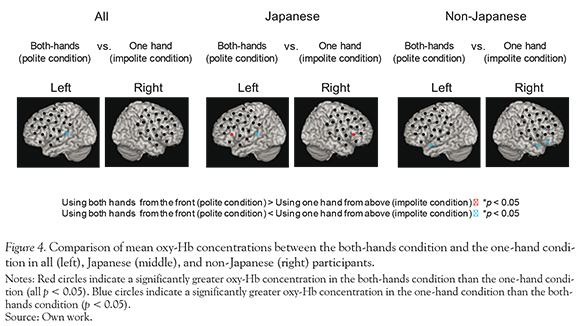
To what extent would the brain reaction to handing actions predict group membership? With regard to this question, we conducted a discriminant analysis on mean oxy-Hb values with the handing conditions (both-hands versus one-hand) as explanatory variables and cultural backgrounds (Japanese versus non-Japanese) as external criteria. Results showed that difference in mean oxy-Hb values in the right area of the inferior frontal region and precentral gyrus significantly discriminated Japanese from non-Japanese groups (right 3ch: Wilks' 1= 0.86, p < 0.05, discriminant hit ratio 66%; right 10ch: Wilks' 1= 0.87, p < 0.05, discriminant hit ratio 62%). Although these ratios were not particularly high, the difference in oxy-Hb concentration values was significantly associated with cultural differences (Table 3).
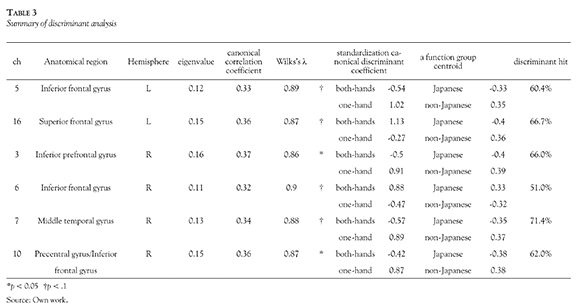
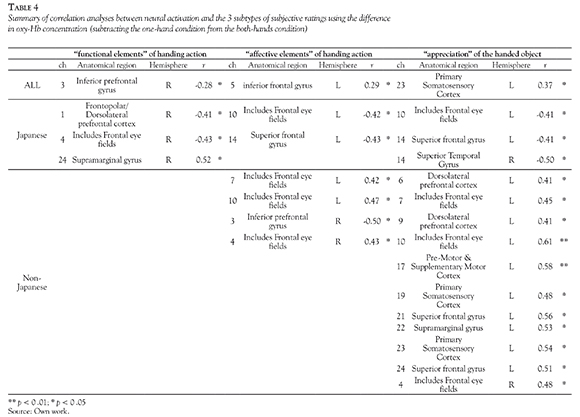
Neural activation and subjective ratings
We analyzed the correlation between neural activation and the three subtypes of subjective ratings using the difference in oxy-Hb concentrations (subtracting the one-hand condition from the both-hands condition), separately for the Japanese and non-Japanese groups. With the subjective ratings of functional elements, the Japanese participants showed a positive correlation with the right supra-marginal region and a negative correlation with the right middle frontal region ( p < 0.05; Table 4), while the non-Japanese showed no significant correlations. With subjective ratings of affective elements, the Japanese participants showed a negative correlation with the left superior and middle frontal regions ( p < 0.05; Table 4), while the non-Japanese participants showed positive correlations with the bilateral middle frontal regions and a negative correlation with the right inferior prefrontal region ( p < 0.05; Table 4).
Regarding subjective ratings of appreciation of the product, Japanese participants showed negative correlations with the left middle (p < 0.05; Table 4) and superior frontal regions, and the right superior temporal region, whereas the non-Japanese participants showed positive correlations with a large area of left middle and superior frontal, supramarginal regions and the right middle frontal region ( p < 0.01; Table 4). These results demonstrate that when observing handing actions with one hand or with both hands, brain reactions indicated by oxy-Hb concentrations were evident in the frontal and parietal lobes with regard to functional and appreciation aspects of the product, while with regard to affective elements, brain reactions were mainly found in the frontal lobe.
In addition, there were differential patterns of brain activities associated with the subjective ratings. In the Japanese group, when the subjective rating of "easy to receive" using both-hands was high, oxy-Hb concentration in the inferior parietal cortex was also high. This is similar to other results showing that relative oxy-Hb concentrations measured by NIRS increased to a greater extent during the observation of "appropriate" receiving actions than during the observation of "inappropriate" ones (Shibata, Suzuki, & Gyoba, 2007). In the non-Japanese group, oxy-Hb concentrations in the precentral regions and parietal lobe were high when the subjective rating of "appreciation of the product" was high. Also, oxy-Hb concentrations in the middle frontal gyrus were high when the subjective ratings of the "appreciation of the product" subgroup and the "affective elements" subgroup were high. The middle frontal gyrus is known because it activated with increasing degrees of uncertainty during decision-making (Volz, Schubotz, & Cramon, 2005). These results suggest that handing actions using both hands led to uncertainty in the non-Japanese participants, and that there might be cultural differences in the subjective ratings and related oxy-Hb brain reactions for handing action using both hands.
Discussion
Results showed different amounts of changes in the concentration of oxy-Hb in the participants' inferior frontal regions, depending on whether one hand or both hands were used for handing an object (a bottle) to them. Moreover, the pattern of brain reactions in the inferior frontal regions differed between our Japanese and non-Japanese participants. The discriminant analysis of difference in oxy-Hb values suggested that the greater oxy-Hb reaction in the right side of inferior frontal regions in the both hands condition could predict that the participant was more likely to be Japanese than non-Japanese. This finding is partly in agreement with a fMRI study with Japanese participants by Shibata, Inui, and Ogawa (2011), which demonstrated greater reactions in the inferior frontal gyrus with compatible (and therefore easy to receive) handing actions compared to incompatible ones.
It has been reported that the inferior frontal gyrus (IFG) responds to movements of significant degree or special meaning (Grosbras, Beaton, & Eickhoff, 2012). Handing an item with two hands when it could be done with one hand requires extra movement and is unnecessary, in terms of the functional goal of the movement. Differences in reactions in the IFG to both-hands and one-hand conditions found in this study could be attributed to the interpretations of the both-hands movement necessitated, because it exceeds its functional goal of handing an item. During hand actions, the IFG is activated when the hand may respond to the agent's intention of the action in context (Iaco-boni et al., 2005). It is possible that the results of the present study indicate a psychological process regarding movements that convey a special meaning. Specifically, the recipient-observer of both-hands handing, while one-hand would be sufficient, might have interpreted the action as an expression of intentional politeness, which is different from the merely functional aspect in the context of a sales counter. Also, with regard to the subjective ratings of the Japanese participants, the functional element of easiness to receive the object correlated with affective elements of actions in the both-hands condition. In the non-Japanese participants, no such correlation was found. It can be inferred from these results that with both-hands handing, for the Japanese participants, an action of another person that could be characterized as being easy to receive also may evoke a positive feeling toward the agent of the action. This could have happened because of the cultural background ofJapanese people, who are accustomed to thinking there are affective elements, such as consideration and respect toward the other, in handling an object with both hands, which is beyond the functional purpose. Even more so, because "polite capitalism" is a common practice in Japan, the setting of the present study with a face-to-face interaction in a sales counter context might have been influential.
In contrast, the non-Japanese participants interpreted the functional and affective elements of both-hands handing independently. The reason for this difference between Japanese and non-Japanese participants is unclear. However, it is possible the functional and affective elements of both-hands handing did not correlate in the non-Japanese group because a cultural background effect such as polite capitalism in a face-to-face interactions with a sales person played significant role with the non-Japanese participants. Some non-Japanese participants reported their impression that both-hands handing was too formal, difficult to receive, and inefficient. The difference in brain reactions between the Japanese and non-Japanese participants might be attributed to the expectation that non-Japanese are more used to friendly and efficient behavior by a sales person at a sales counter than distinctly polite behavior.
Additionally, the affective elements were shown to be associated with oxy-Hb concentrations in the frontal regions in both Japanese and non-Japanese people. Based on these results, it can be inferred that with the Japanese participants, oxy-Hb concentrations in the frontal lobe were greater in the both-hands handing condition than in the one-hand condition, indicating a reaction to affective, as well as functional elements. The present study demonstrated different perceptions of the same action due to tradition and culture of the recipient, by using the measurement of neural activities. It is possible that even in the non-Japanese group, if both-hands handing becomes a well-known, familiar action experienced at sales counters, neural activities similar to the Japanese participants would be observed, as speculated by Wadsworth and Kana (2011).
Furthermore, this study compared two groups that differed in their cultural backgrounds and found the brain response for the handing actions was considerably different. Previously, non-verbal behaviors such as smiling and personal space, as well as handshakes have been studied mainly by using observations and behavioral measures (Scollon & Scollon, 1995). In addition, there have been reports that oxy-Hb concentrations in response to everyday, ordinary behavior are affected by whether the behavior is performed alone or in coordination with another person in a face-to-face relationship (Koehler et al., 2012; Wakita & Hiraishi, 2011), and whether the perspective of the agent of the behavior is the agent's own, or that of another (Egetemeir, Stenneken, Koehler, Fallgatter, & Herrmann, 2011). However little research has examined cultural differences in interpreting nonverbal behavior in face-to-face, real interpersonal settings.
The differential patterns of brain responses we found are difficult to interpret due to their complex relationships to subjective ratings, the imbalance of diversity between our Japanese and non-Japanese participants, and inherent ambiguity in the interpretation of NIRS signals. However, it remains possible that a difference in the perception of a daily behavior in a setting that reflects participants' cultural backgrounds did manifest itself as a difference in blood flow concentrations in the brain.
The human mirror neuron system may be hypothesized as a neurophysiological basis of the simulation theory, which states that understanding the psychological states of others is accomplished by simulating them from the observer's perspective (Iacoboni, 2008). The results of the present study showed that the NIRS signals in the frontal and parietal region, which may be considered as a part of the human mirror neuron system, were not associated simply with the subjective ratings of the performed actions. That is, even though the handing actions with both hands consistently produced more positive subjective rating scores, the frontal and parietal brain responses varied between the different groups of participants.
Merely observing the behavior of others does not always activate the mirror neuron system in the observer. It has been reported that when the observed behavior is not a part of the repertoire of the observer's normal behaviors, and the observer does not understand its purpose, little neural activity is detected in the observer (Caspers et al., 2010).
One possible reason that little reaction was observed in the fronto-parietal mirror neuron system of the non-Japanese participants, in response to both-hands handing, could be because the purpose of deliberately handing an object with two hands, when it could be handed with just one hand, was unclear to them. It still remains to be investigated what brought about the differential brain reactions to handing actions with regard to cultural differences. In future research, as a further step to investigate the brain mechanism involved in interpreting the "politeness" of actions, it would be important to use groups with more homogeneity. Alternatively, a study with an additional condition in which a non-Japanese agent, in addition to the Japanese agent, performs the actions would also be informative. In addition it would be important to measure broader and deeper regions of the brain by using fMRI.
This is because understanding the functional as well as affective elements of another's actions might require the "mentalizing network." Overwalle (2009) concluded from a meta-analysis of over 200 fMRI studies related to social cognition that the network of frontal lobe-parietal lobe and medial prefrontal cortex (mPFC) is involved in processing thoughts regarding the self and others as well as norms and scenarios regarding interpersonal relationships, while the temporo-parietal junction (TPJ) is involved in processing goals and intentions as well as requests from others. These areas could comprise a mentalizing network in a greater sense that includes desires, preferences and inferences of personality characteristics, in addition to understanding the beliefs of and knowledge of others as measured by the theory-of-mind false belief task (Amodio & Frith, 2006). Liew, Han, and Aziz-Zadeh (2011) have suggested that familiarity and intimacy with a gesture causes changes to regions of the mirror neuron system and to mentalizing. Studying the TPJ and inner area of the frontal and parietal lobes could provide information on how understanding affective intentions toward another, as well as differences in culture and life practices, relate to the neural network of social cognition.
Research on the manifestation of cultural differences in the brain would likely prove useful for a deeper understanding of nonverbal behavior, which often can be misinterpreted in interpersonal communication across cultures.
Conclusions
Handing actions using both hands (presumably polite action) and using one hand from above (presumably impolite action) evoked differential brain activities in the inferior frontal regions of recipients. Also higher oxy-Hb concentrations in the inferior frontal regions in Japanese participants with the agent using both hands correlated with ratings of courtesy, whereas higher oxy-Hb concentrations in the inferior frontal region in non-Japanese participants using one hand from above did not correlate with politeness ratings. Additionally, with regard to the subjective ratings, functional ratings and positive affective ratings were found to correlate in the both-hands condition with the Japanese participants, but not with the non-Japanese participants. Although the polite actions produced overall higher affective evaluations, the pattern of brain reactions differed significantly between Japanese and non-Japanese participants, indicating that the brain responses were prone to influences based on differences in culture and customs.
Foot Note
1The definition of "politeness," which includes respect and consideration toward others, is inevitably ambiguous because it depends on various social contexts. In the present paper, we termed a handing action from front with both hands as a polite action and a handing action from above with one hand (i.e., drawing an arc) as an impolite action because all participants described the both-hands actions as polite and the one-hand action as impolite (see the method and the result sections).
References
Adams, R. B., Rule, N. O., Franklin, R. G., Wang, E., Stevenson, M. T., Yoshikawa, S., ... Ambady, N. (2009). Cross-cultural reading the mind in the eyes: An fMRI investigation. Journal of Cognitive Neuroscience, 22(1), 9-108. [ Links ]
Amodio, D. M., & Frith, C. D. (2006). Meeting of minds: the medial frontal cortex and social cognition. Nature Reviews Neuroscience, 7(4), 268-277. [ Links ]
Brown, P. & Levinson, S. (1987). Politeness: Some universals in language usage. New York: Cambridge university press. [ Links ]
Caspers, S., Zilles, K., Laird, A. R., & Eickhoff, S. B. (2010). ALE meta-analysis of action observation and imitation in the human brain. NeuroImage, 50(3), 1148-1167. [ Links ]
Egetemeir, J., Stenneken, P., Koehler, S., Fallgatter, A. J., & Herrmann, M. J. (2011). Exploring the neural basis of real-life joint action: measuring brain activation during joint table setting with functional near-infrared spectroscopy. Frontiers in Human Neuroscience, 5. [ Links ]
Grosbras, M. H., Beaton, S., Eickhoff, S. B. (2012). Brain regions involved in human movement perception: A quantitative voxel-based meta-analysis. Human Brain Mapping, 33(2), 431-454. [ Links ]
Hoshi, Y., Kobayashi, N., & Tamura, M. (2001). Interpretation of near-infrared spectroscopy signals: a study with a newly developed perfused rat brain model. Journal of Applied Physiology, 90, 1657-1662. [ Links ]
Iacoboni, M., Molnar-Szakacs, I., Gallese, V., Buccino, G., Mazziotta, J. C., & Rizzolatti, G. (2005). Grasping the intentions of others with one's own mirror neuron system. PLoS Biology, 3(3), 529-535. [ Links ]
Iacoboni, M. (2008). Mirroring people: The new science of how we connect with others. New York: Farrar, Straus, and Giroux. [ Links ]
Ikegami, E. (2005a). Bonds of civility: Aesthetic networks and the political origins of Japanese culture. New York: Cambridge university press. [ Links ]
Ikegami, E. (2005b). [Aesthetic networks and the political origins of Japanese culture] (p.443). Tokyo: NTT Publishing. [ Links ]
Koehler, S., Egetemeir, J., Stenneken, P., Koch, S. P., Pauli, P., Fallgatter, A. J., & Herrmann, M. J. (2012). The human execution/observation matching system investigated with a complex everyday task: A functional near-infrared spectroscopy (fNIRS) study. Neuroscience Letters, 508(2), 73-77. [ Links ]
Liew, S.-L., Han, S., Aziz-Zadeh, L. (2011). Familiarity Modulates Mirror Neuron and Mentalizing Regions During Intention Understanding. Human Brain Mapping, 32(11), 1986-1997. [ Links ]
Obrig, H., Israel, H., Kohl-Bareis, M., Uludag, K., Wenzel, R., Muller, B., & Villringer, A. (2002). Habituation of the visually evoked potential and its vascular response: Implications for neurovascular coupling in the healthy adult. NeuroImage, 17(1), 1-18. [ Links ]
Okamoto, M., Dan, H., Sakamoto, K., Takeo, K., Shimizu, K., Kohno,.,. Dan, I.(2004). Three-dimensional probabilistic anatomical cranio-cerebral correlation via the international 10-20 system oriented for transcranial functional brain mapping. NeuroImage, 21(1), 99-111. [ Links ]
Okamoto, M., & Dan, I. (2005). Automated cortical projection transcranial functional brain of head-surface locations for mapping. NeuroImage, 26(1), 18-28. [ Links ]
Overwalle, F. V. (2009). Social cognition and the brain: A meta-analysis. Human Brain Mapping, 30(3), 829-858. [ Links ]
Overwalle, F. V. (2009). Social cognition and the brain: A meta-analysis. Human Brain Mapping, 30(3), 829-858. [ Links ]
Rizzolatti, G., Fadiga, L., Gallese, V., & Fogassi, L. (1996). Premotor cortex and the recognition of motor actions. Cognitive Brain Research, 3(2), 131-141. [ Links ]
Rizzolatti, G., Fogassi, L., & Gallese, V. (2001). Neuro-physiological mechanisms underlying the understanding and imitation of action. Nature Reviews Neuroscience, 2(9), 661-670. [ Links ]
Scollon, R. & Scollon, S, W. (1995). Intercultural communication: A discourse approach. Oxford : Blackwell Publishing. [ Links ]
Shibata, H., Suzuki, M., & Gyoba, J. (2007). Cortical activity during the recognition of cooperative actions. Neuroreport, 18(7), 697-701. [ Links ]
Shibata, H., Inui, T., & Ogawa, K. (2011). Understanding interpersonal action coordination: an fMRI study. Experimental Brain Research, 211(3-4), 569-579. [ Links ]
Strangman, G., Culver, J. P., Thompson, J. H., & Boas, D. A. (2002). A quantitative comparison of simultaneous BOLD fMRI and NIRS recordings during functional brain activation. NeuroImage, 17, 719-731. [ Links ]
Surak, K. (2006). 'Ethnic practices' in translation: Tea in Japan and the US. Ethnic and Racial Studies, 29(5), 828-855. [ Links ]
Touyama, Y. (1991). Aspects of Japanese nonverbal behavior in relation to traditional culture. In U. Ikegami, (Eds.), The empire of signs (p.181-218). Amsterdam: John Benjamins publishing company. [ Links ]
Volz, K. G., Schubotz, R. I., & von Cramon, D. Y. (2005). Variants of uncertainty in decision-making and their neural correlates. Brain Research Bulletin, 67(5), 403-412. [ Links ]
Wadsworth, H. M., & Kana, R. K. (2011). Brain mechanisms of perceiving tools and imagining tool use acts: A functional MRI study. Neuropsychologia, 49(7), 1863-1869. [ Links ]
Wakita, M., & Hiraishi, H. (2011). Effects of handedness and viewing perspective on Broca's area activity. Neuroreport, 22(7), 331-336. [ Links ]













